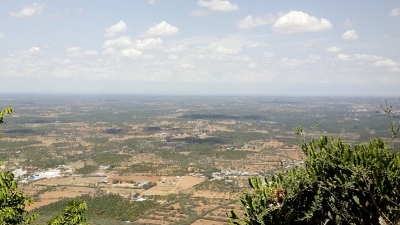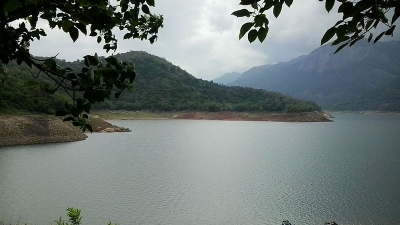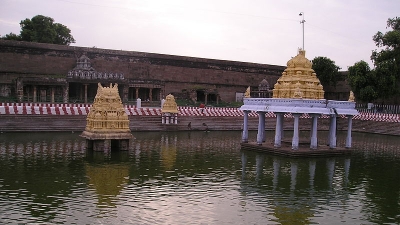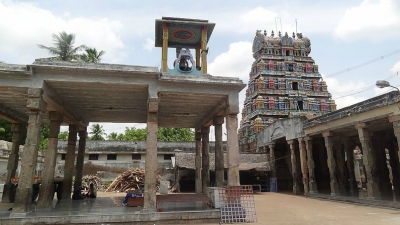Thiruvannamalai Attractions - Tourist Places To Visit In Thiruvannamalai
-
01Adi Annamalai Temple
+ Read MoreAdi Annamalai Temple is the oldest known temple in and around the areas surrounding Thiruvannamalai. The temple was built at least a century before the construction of the Arunachaleswara Temple was even started. Hence, it is believed to be almost 2000 years old.
Initially the temple was believed to be a simple structure of wood containing the idols of various Gods and Goddesses. It was only later that gopurams were added and the wooden structure was brought down for building a temple of bricks and stone. The present form of the temple is known to have been in existence for over 1200 years now.
‘Adi’ stands for first in the local language and hence is an apt name for the temple. The temple was built much before the Arunachaleswara Temple but is miniscule in comparison to the latter. The temple stands on an area of only ½ acre. The lingam that is worshipped in the temple is believed to have been built by Lord Brahma Himself.
-
02Arunachaleswara Temple
+ Read MoreArunachaleswara Temple in Thiruvannamalai is situated on the foothills of the Annamalai Hill and is a major place of worship for the Hindus. The temple is dedicated to Lord Shiva and has a lot of significance for the followers of Saivism.
In the temple is placed a lingam, which represents Shiva and the God is worshipped here along with his wife Parvati who is worshipped as Unnamulaiyamman. The temple represents the element of Agni or Fire and Lord Shiva is worshipped in the form of Agni lingam. The Temple has been mentioned in the canonical work of Tamil saint poets who were called ‘nayanars’.
It is, in fact, one of the largest temples in the country and is built on an area covering 10 hectares. The temple is majestically built with four gateway towers called the gopurams. The tallest gopuram is on the east side and is of a height of 66 m making it India’s tallest gopuram. The gopuram comprises of 11 storeys.
-
03Sathanur Dam
+ Read MoreThe Sathanur Dam in Thiruvannamalai district is one of the important dams of South India that was built in 1958, to meet the drinking and irrigation needs of the people of Thiruvannamalai and the surrounding villages. The Dam is built over the rivers Pennaiyar and Thenpennai that flow through Thandarmpet Taluk in the Chennakesava Hills.
The dam is 30 km from the Thiruvannamalai town and can be reached via a good network of roads from the town to the dam. The dam is a must visit not only for the scenic view of the rivers that it offers, but there is also a crocodile farm on the banks of the river and a fish grotto.
Near to the dam is a park that is maintained by the authorities and is very popular among tourists looking for a picnic spot. The park is also used by the South Indian film industry for shooting songs.
-
04Ramana Ashram
+ Read MoreRamana Ashram, also called the Sri Ramanasraman, is an ashram or a religious institute that has been built on the grounds of what used to be the home of Ramana Maharishi. He was a modern philosopher who lived in the town of Thiruvannamalai from 1922 until 1950. The Ashram is situated in the foothills of the Arunachala Hill towards the west side of Thiruvannamalai district.
At the time of the Maharishi’s death in 1950, thousands of his followers had gathered at the place to catch a glimpse of the revered sage before he left for his heavenly abode. Even after his death, many of his followers and curious tourists visit the Ashram.
There is now a shrine dedicated to the Maharishi at the place where he breathed his last. And each year, his followers make it a point to visit the Ashram and spend some time there doing social services.
-
05Virupaksha Cave
 + Read More
+ Read MoreVirupaksha Cave has had religious importance since the 14th century. Initially the Cave was popular due to the saint Virupaksha Deva, but now the Cave is known among the devotees because of Sri Ramana Maharishi. The Maharishi made the Cave his home for 16 years starting from the year 1899. He came out of the Cave only on 1916.
He wrote ‘Self-inquiry’ and ‘Who am I’ while residing in the Cave. This is one reason the Cave has acquired shrine-like importance for the followers of Sri Ramana Maharishi. Many people come to meditate inside the Cave to find inner peace. The way to Virupaksha Cave is through Sri Ramana Ashram and you cross Skandashram on your way.
You also have the option of walking from the Thiruvannamalai Temple and the Arunachaleswara Temple in order to reach the Virupaksha Cave. Many devotees prefer walking from the main temple of Thiruvannamalai to the Cave because they consider this as part of the pilgrimage and a way of paying their respect and homage to the revered saints.
-
06Seshadri Swamigal Ashram
+ Read MoreThe Seshadri Swamigal Ashram in Thiruvannamalai district lies close to Ramana Ashram. The Ashram is on the same road as the Sri Ramana Ashramand and is separated from the latter by three buildings.
The Swamigal Ashram also offers accommodation to the devotees who come from outside the town. The accommodation fee is very nominal and is also sometimes excused for those who cannot afford to pay it.
The Ashram was established by Seshadri Swamigal who was popularly called the ‘Saint with a golden hand’. People in South India worship the saint and he is considered one of the most admirable of Indian saints who ever lived.
The saint was born in Thiruvannamalai and dedicated most of his life for the financial and spiritual empowerment of the people. This is the main reason the saint has acquired the status of semi-God and is worshipped by many people all over the world.
-
07Skandashram
 + Read More
+ Read MoreThe Skandashram was established by Kandasawmi who took the initiative of getting constructed the primary part of the building that is now known as Skandashram. The Ashram is actually a cave that is very close to the Virupaksha Cave. The Ashram has a perennial spring that gives out clean and safe water for drinking purposes.
The ventral side of the cave has two rooms that have been constructed in linearity. The terrace of the ashram offers a splendid view of nature at its best. The thick and green growth of foliage combined with the azure of the sky is indeed breathtaking.
Visible on the skyline of the town are the majestic gopurams of the Arunachaleswara as well as the Thiruvannamalai Temples. It is believed that Bhagavan stayed in this Ashram until the death of his mother, Alagammal in 1922. Legend also has it that Sri Ramana’s mother attained Samadhi at this Ashram in 1922.
-
08Mamara Guhai
 + Read More
+ Read MoreMamara Guhai is a Hindu temple located in the town of Thiruvanamalai. The literal meaning of Mamara Guhai is ‘mango tree cave’ and the temple is actually a cave that has been turned into a shrine. Overlooking the cave is a mango tree.
The cave has a lot of religious significance for the local Hindu population. Saint Ramana Maharishi meditated in this cave temple for six long years. Inside the temple are three idols, one of Lord Shiva and the other two are of Goddesses.
In the temple is one of the forms of Lord Shiva, the ‘Vishwanthar’, who is considered the lord of the world. The idols representing the female form are of the Goddesses Rajarajeshwari and Annaporna Devi.
Inside the temple are enshrined the lingams of Siddha Gurus. The Siddhars are the followers of Siddha gurus and worship them in the form of lingams since they are considered forms of Lord Shiva.
-
09Annamalai Hills
+ Read MoreThe Annamalai Hills are part of the Western Ghats that run through the states of Kerala, Karnataka and Tamil Nadu. The Hills get their name from the combination of two words, ‘Anai’ and ‘Malai’. The former means elephant and the latter means hill. Hence, Annamalai stands for the Elephant Hill, a very apt name given the abundant wildlife of the hills.
Anamudi is the highest peak of the Annamalai Hills and is at a height of 2,694 m above sea level. This peak lies in the Idduki district of Kerala. The UNESCO World Heritage Committee is considering the Western Ghats including the Annamalai Hills as potential World Heritage Sites.
In the Annamalai Hills lie the Ervaikulum National Park, Paramabikulum Wildlife Sanctuary, The Indira Gandhi Wildlife Sanctuary and National Park, Chinnar Wildlife Sanctuary and the Anamalas Tiger Reserve.
All these parks and sanctuaries are known for keeping huge tusks. Other forms of animal life include the gaur, tigers, panthers, civet cats, sambar, dhole, sloth bears and water buffaloes.
-
10Ashta Lingams
 + Read More
+ Read MoreAshta Lingams or the eight lingams are situated in the Thiruvannamalai district of Tamil Nadu and are found on the foothills of the Annamalai Hill. The town of Thiruvannamalai is known to reverberate with all that is holy and spiritual mainly because of the presence of the Ashta lingams.
These lingams attract saints and devotees alike to the place. There are eight small shrines housing the lingams. These shrines are all placed at some distance from each other on the 14 km circumference of the foothill. Pilgrims are known to go around the hill in order to offer their prayers. They also make it a point to pray at every lingam.
The eight lingams are the Indra lingam, the Agni lingam, the Vayu Lingam, the Varuna lingam, the Niruthi lingam, the Kubera lingam and the Isaanya lingam. Each of these lingams is associated with the twelve moon signs. Worshipping the eight lingams is an integral part of the ‘Girivalam’ or circumbulation of the hill.
-
11Pachaiamman Kovil
 + Read More
+ Read MorePachaiamman Kovil or Pachaiamman Koil is an ancient temple that is situated on the outskirts of Thiruvannamalai. The temple is believed to be at least 1000 years old although its present structure is only 120 years old. The Goddess Parvati, consort of Lord Shiva is worshipped in this temple in the form of Pachaiamman.
This form of the Goddess is believed to have been created to build peace and unanimity in the world. The temple is also known as the place where Sri Ramana Maharishi took refuge for six months in the year 1905, when a plague broke out in Thiruvannamalai. The Maharishi escaped the infection after relocating to the temple from the Virupaksha Cave.
The temple is visited by people who walk the Pradakshina or the sacred path followed by the saints. The temple is on the Inner Path and is not accessible via the Outer Path. After the Maharishi went back to the Virupaksha Cave, he would regularly visit the temple for oil baths.
-
12Arahanthgiri Jain Math
 + Read More
+ Read MoreThe Arahanthgiri Jain Math is located in Thiruvannamalai district of Tamil Nadu and the math holds religious significance for the entire Jain community of India. This Jain math was started in the year 1998 with the main aim of providing community service to the destitute.
Inside the math are several complexes comprising of four Jain temples, three Jain caves and a sculpture of Neminatha that is 16 m high. It is the tallest such structure in Tamil Nadu and is believed to be dated as old as 12th century.
A very famous south Indian movie has been shot around the theme of Neminatha. Bhattaraka Dhavalakeerthi is the head of the math, and he has started many programs for the empowerment of the poor and needy. He has opened schools where children of the poor are given free education and taught a vocational skill to help them earn a living once they grow up.
-
13Padavedu Renukambal Temple
 + Read More
+ Read MorePadavedu Renukambal Temple lies in the Padavedu town and is at a distance of 7 km from Thiruvannamalai. The temple has religious significance for the Hindus because it is one of the sights for Shakti Sthals. There is also a lingam adorning the temple that is called the Somanathalingam.
Legend has it that Lord Parasurama (an avatar of Lord Vishnu) committed matricide on the insistence of his father Rishi Jamadagni. While cutting off the head of his mother Renuka Devi, Parasurama is believed to have cut off the head of a washerwoman as well. On being granted a boon by Rishi Jamadagni, Parasurama asked for bringing His mother back to life.
The Rishi granted Him the boon and asked Him to attach the body of his mother with her severed head. However, the Lord ended up joining His mother’s torso to the washerwoman’s head and vice versa. It is the head of Renuka Devi joined to the body of the washerwoman that is worshipped in the Padavedu temple as Renukambal.
-
14Nedungunam Ramar Temple
 + Read More
+ Read MoreNedungunam Ramar Temple is a Vishnu temple dedicated to Lord Rama, one of the avatars of Vishnu. The temple, which is situated in Thiruvannamalai, is the biggest Vishnu temple in the whole of the district. The shrine is believed to be at least 700 years old and was renovated by many kings after its construction.
The unique feature of this temple is the idol of Lord Rama that shows Him in a sitting position and without his bow. This sitting position is referred to as Yoga Ramar, and the God’s right hand is placed very close to his heart in what is known as the Gnana Muthirai position.
Sri Anjaneya or Lord Hanuman is sitting in front of Rama and reading from the Brahma Sutra written on palm leaves. Sita, Rama’s consort is seated next to Him on a peetam that is carved with the heads of lions. The idol of lord Rama is one of its kind and is the main attraction among the pilgrims because the Lord is shown here in a never before seen pose.



 Click it and Unblock the Notifications
Click it and Unblock the Notifications











